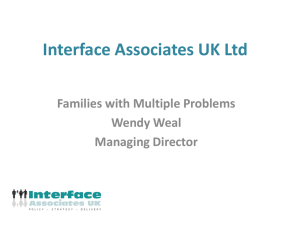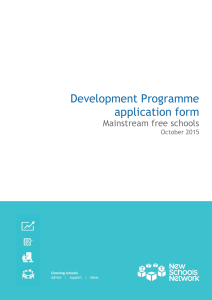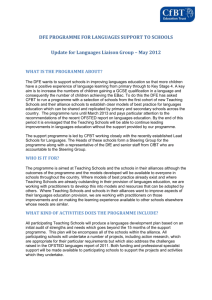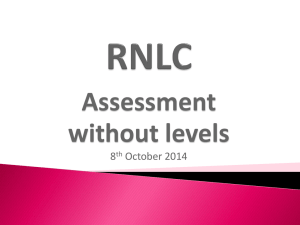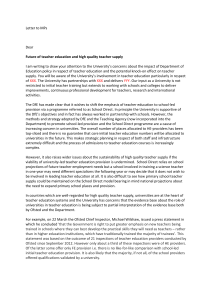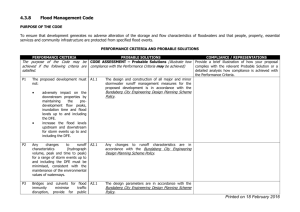Catch22 Proposal to the DfE Innov osal to the DfE Innovation Fund
advertisement
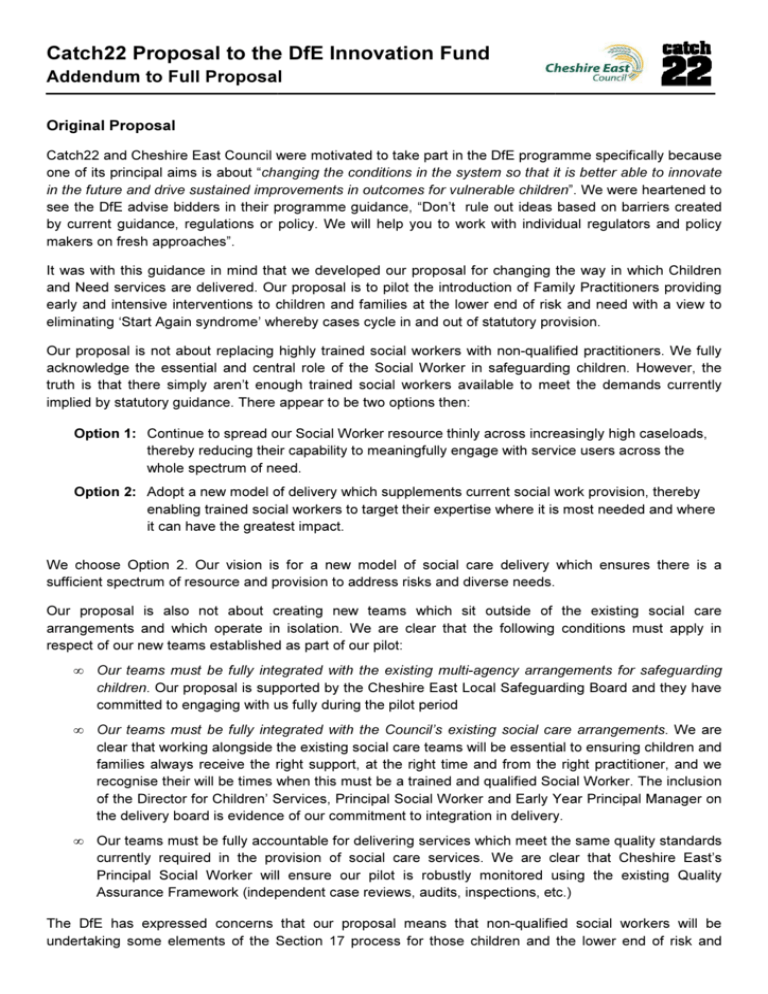
Catch22 Proposal to the DfE Innovation Fund Addendum to Full Proposal Original Proposal Catch22 and Cheshire East Council were motivated to take part in the DfE programme specifically specific because one of its principal aims is about “changing changing the conditions condition in the system so that it is better able to innovate in the future and drive sustained improvements in outcomes for vulnerable children”. children We were heartened to see the DfE advise bidders in their programme guidance, “Don’t rule out ideas based on barriers created by current guidance, regulations or policy. We will help you to work with individual regulators and policy makers on fresh approaches”. It was with this guidance in mind that we developed our proposal for changing the way in which Children and Need services are delivered. Our proposal is to pilot the introduction of Family Practitioners providing early and intensive interventions to children and families at the lower end of risk and need with a view to eliminating ‘Start Again syndrome’ whereby cases cycle in and out of statutory provision. Our proposal is not about replacing highly trained social workers with non-qualified non qualified practitioners. practiti We fully acknowledge the essential and central role of the Social Worker in safeguarding children. However, the truth is that there simply aren’t enough trained social workers available to meet the demands currently implied by statutory guidance. There ere appear to be two options then: Option 1: Continue ontinue to spread our Social Worker resource thinly thin across increasingly high caseloads, thereby reducing their capability to meaningfully engage with service users across the whole spectrum of need. Option 2: Adopt a new model of delivery which supplements s current social work provision, thereby enabling trained social workers to target their expertise where it is most needed and where it can have the greatest impact. We choose Option 2. Our vision is for a new model of social care delivery which ensures there is a sufficient spectrum of resource and provision to address risks and diverse needs.. Our proposal is also not about creating c new teams which sit outside of the existing social care arrangements and which operate in isolation. We are clear that the following conditions condition must apply in respect of our new teams established as part of our pilot: pilot • Our teams must be fully ully integrated with the existing multi-agency multi agency arrangements for safeguarding children. Ourr proposal is supported by the Cheshire East Local Safeguarding Board and they have committed to engaging with us fully during the pilot period • Our teams must be fully ully integrated with the Council’s existing social care arrangements. arrangements We are clear that working alongside the existing social care teams will be essential to ensuring children and families always receive the right support, at the right time and from the right practitioner, and we recognise their will be times when this must be be a trained and qualified Social Worker. Worker The inclusion of the Director for Children’ Services, Principal Social Worker and Early Year Principal Manager on the delivery board is evidence of our commitment to integration in delivery. • Our teams must be fully accountable for delivering services which meet the same quality standards currently required in the provision of social care services. services We are clear that Cheshire East’s Principal Social Worker will ensure our pilot is robustly monitored using the existing Quality Assurance Framework (independent case reviews, audits, inspections, etc.) The DfE has expressed concerns that our proposal means mean that non-qualified qualified social workers will be undertaking some elements of the Section 17 process for those children and the lower end of risk and Catch22 Submission to the DfE Innovation Fund - Addendum need, and that this goes against existing guidance and statutory requirements. It does, and this isn’t because we believe social workers aren’t required at the higher end of risk and need (we believe they are essential when the risks and needs in question are acute). acute) Rather, it’s t’s because we believe that applying the existing guidance and statutory requirements across across the whole spectrum of risk and need leaves you only with Option 1 – spreading Social Worker resource too thinly. thinly To this end the current guidance and statutory requirements are just the types of barriers barrier to innovation we believe the programme is aspiring to remove. The DfE also suggest that the lack of Social Workers in our proposal is made more problematic by the fact that Catch22 would be delivering pilot on behalf of Cheshire East. It’s suggested that this goes against the requirements of the Children n and Young People’s act, specifically that the work undertaken by Catch22 will be ‘discharged by, or under the supervision of, registered social workers’. It would, and for the same reasons outlined above. One of the central principles of our proposal is that Social Workers should be freed up to focus on children and families at the he higher end of risk and need, and this is the case regardless of who might deliver those services at the lower end of need, providing the three conditions for integration and quality q assurance identified above are met. Requiring that Social Workers oversee all of the work at the lower end of risk and need is simply another version of Option 1 – spreading Social Worker resource too thinly. thinly Alternative Proposal Models We contend that hat our original proposal offers the best opportunity for realising significantly improved outcomes for young people and families, amilies, and therefore the greatest value for money. However, if the DfE are unable to support this proposal due to its contravening current current statutory guidance and legislation, then we are still keen to test the effectiveness of expanding the spectrum of social care provision through the introduction duction of Family Practitioner teams. Therefore, T we have developed two variant models which introduce qualified and registered social workers within each pod undertaking the role of Senior Practitioner. Our Senior Practitioners will hold absolute accountability for the cases held by the pod teams. They will oversee the work of the Family Practitioners, ractitioners, providing advice and guidance on best practice and in relation to policy, standards, legislation etc.. We will also ensure that our Senior Senior Practitioners sign off all Action Plans lans for work with children and families, in so doing identifying those those cases requiring a heightened degree of oversight and guidance. They will review risks and needs on an ongoing basis providing accountability and support and enabling the development of the skills and knowledge of all the team. We will also ensure that our ur Senior Manager is a qualified Social Worker who is experienced at a senior management level. Although not in line with our original proposal intentions, we do feel this signifies the professional respect we have for the Social Worker’s role and we hope this helps to satisfy the issues raised by the DfE by aligning our proposal more closely with the current regulatory framework. We view these alternative models, the pilot as a bridge, a stepping stone that will enable us to test new approaches before further consideration of our more radical approach. Variant Proposal 1 • We retain the existing structures originally proposed, with three pod teams comprising seven family practitioners and a team administrator. However, the Team Managers in each pod shall now be qualified social workers operating as the Senior Practitioner. See Figure 1. Catch22 Full Proposal to the DfE Innovation Programme – Addendum to Full Submission Page 2 of 5 Catch22 Submission to the DfE Innovation Fund - Addendum Variant Proposal 2 • Should the DfE consider that a greater degree of Social Worker orker oversight is required than is afforded by Variant Proposal 2, we would be open to reconfiguring our pod structures with a view to lessening the ratio of Family Practitioners (and therefore cases) to Senior Practitioners from 7:1 to 5:1. • Under this arrangement we would propose retaining ret the cohort size (so so as not to lose scale in outcomes and value for money), money but to have this cohort managed by four pods, each comprising five Family Practitioners, one administrator and a qualified social worker as the th Senior Practitioner for the team. See Figure 2. • The role of the Senior Practitioner in each team would remain the same as for Variant 1, 1 but they would be accountable for and oversee fewer cases as a consequence of the smaller pod configurations. Figure 1: Variant Proposal A Pod Structure – Each pod will include a qualified and registered social worker Figure 2: Variant Proposal B Pod Structure – The introduction of an additional pod, each with fewer family practitioners increases the level of Senior Practitioner oversight afforded in the pilot. Catch22 Full Proposal to the DfE Innovation Programme – Addendum to Full Submission Page 3 of 5 Catch22 Submission to the DfE Innovation Fund - Addendum Financial Implications Reconfiguring our Pod teams will have an impact on the financial requirements for our proposal and we have summarised these changes in Table 1. Essentially the changes result from an uplift in costs to account for introduction of enhanced Senior Practitioner role. Variant B also see the inclusion of an additional Senior Practitioner and Administrator Admin and the removal of one Family Practitioner post (taking the total down to 20). A full cost model for each variant proposal is available upon request should they be required. Table 1: Variant Proposal financial summary – each variant proposal would require e additional funding over and above that originally requested. Cheshire East’s contribution would also increase. Funding Summary Original Proposal Variant 1 Variant 2 Requested DfE funding £1370,660 £1,400,381 £1,437,887 Cheshire East Direct funding £356,361 £365,277 £376,529 Cheshire East ‘in kind’ £82,290 £82,290 £82,240 TOTAL PILOT COST £1,809,311 £1,847,948 £1,898,655 BAU running costs (year 2) £1,502,487 £1,538,151 £1,584,958 Additional Clarifications How much money has been set aside for scale and spread? We have not included the cost of scale and spread in our financial summary to the DfE. Our intention is to use the pilot period to refine and improve our new model of CiN delivery working in close collaboration with our key safeguarding partners artners and with the DfE. Therefore, costs associated with scale and spread are likely to change as the model evolves during the period. Catch22 and Cheshire East are confident that the pilot will evidence the value in our delivery model, both in terms of achieving better outcomes and in terms of monies saved. Our intention is to look for alternative funding streams to finance the scale and spread of the model, and one option under consideration is to apply to the Cabinet Office’s Social Outcomes Fund and the Big Lottery’s Commissioning Better Outcomes Fund. These funds are aligned to our vision for the future of this model and for the development of a lasting partnership between Cheshire East Council and Catch22 insofar as both funds are designed to support suppor the development of Social Investment Bonds (SIBs) as a means of driving better outcomes. Our initial thinking around SIBs is outlined further below. What contingencies do we have in place if we don’t secure the funding? Catch22 and Cheshire East strongly believe that our proposal can drive improvements in outcomes for children and families. If we are unable to secure funding from the DfE then we will look to alternative funding opportunities such as Commissioning Better Outcomes and the Social Outcomes Fund, Fu and failing that, we will look to self-finance finance the pilot, even if at a smaller scale. What are the plans concerning the social investment bond? Is the project really sustainable on savings Cheshire East will accrue from running the pilot? We provided a summary of the savings we believe this model will achieve on page 18 of our ou original submission. It’s our contention that the annual operating costs of our delivery model are less than the Catch22 Full Proposal to the DfE Innovation Programme – Addendum to Full Submission Page 4 of 5 Catch22 Submission to the DfE Innovation Fund - Addendum savings achievable through it.. We therefore consider that there is the potential to attract social investment as a means of scaling up and sustaining our model. Out intention is to further develop our thinking around the potential for a SIB arrangement during the pilot period, but essentially the plan would be to attractt social investment for the working capital required to scale up and finance the delivery of the model in other areas.. Cheshire East would thereafter pay a sum for each outcome achieved by the new service, the sum total of which will equate to more than the th original investment, but less than the savings achieved for the Local Authority. This is outlined diagrammatically as Figure 3. Figure 3: High Level SIB structure – Social Investors will receive a return on investment in a JV between Catch22 and Cheshire East Council’s Social Care Team. This return on investment will equate to less than the savings achieved by the new delivery model, with the remaining savings retained retained by the Local Authority. The values used here are based on the costs we have calculated for our model and the savings we that we believe the model will realise. Although initially our thinking around the use of SIBs has focused on scaling and spreading the t model in Cheshire East, in the longer term our view is that this approach could be adopted in collaboration with any Local Authority interested in realising the benefits evidenced by our pilot. Summary Catch22 is keen to participate in the DfE Innovation Inno n Programme and to test a new model for delivering CiN services, and we believe in doing so we can achieve significantly improved outcomes for service users. We understand that the DfE has concerns about the extent to which which our original proposal pushes against the existing guidance and statutory frameworks in place. place We hope that the variant proposals we have developed provide the DfE with a greater degree of comfort around our intentions for delivery. We would welcome the opportunity to discuss our proposal proposal further with the DfE if additional adjustments a are required to enable us to secure the funding funding we require to make a positive impact to the lives of children and families. Catch22 Full Proposal to the DfE Innovation Programme – Addendum to Full Submission Page 5 of 5

